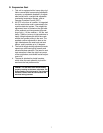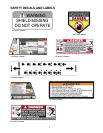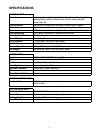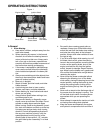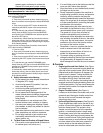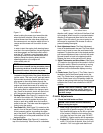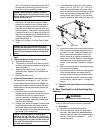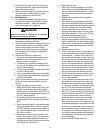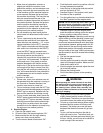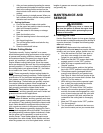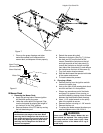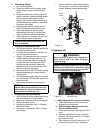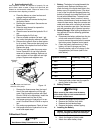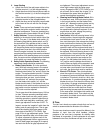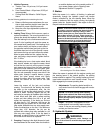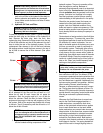
15
1. Make sure no bystanders, animals, or
objects are behind the machine. Look
behind the machine, and use extreme care.
2. Slowly, move both lap bars toward the rear
of the machine until the machine begins to
move rearward. Release the lap bars and
the machine should stop. The more the lap
bars are moved toward the rear of the
machine, the faster the machine will move in
the reverse direction. Release the lap bars
and the machine should stop traveling in
reverse (this is a safety check, the normal
procedure is for the operator to slowly bring
the lap bars to the neutral position).
3. Do not retard the lap bars rapidly as this
could cause turf defacement and/or loss of
traction.
4. To turn, retard one lap bar ahead of the
other and the machine will turn toward the
same side that was retarded — I.E., to turn
counter-clockwise (to the LEFT), move the
LEFT lap bar rearward more than the right
side, and to turn clockwise (to the RIGHT),
move the RIGHT lap bar rearward more
than the left side. NOTE: If one lap bar is in
the neutral position and the other is
retarded, the turn side tire will not rotate and
a “pivot turn” will be executed. Turf deface
-
ment could occur (if on grass) as well as
potential damages to the traction surface
and the tire. If the lap bar on the turn side is
not brought all the way to neutral, then the
turn side tire will continue to rotate and a “U-
turn” will be executed with a low potential for
turf defacement as well as traction surface
and tire damage.
j. To perform a “zero turn”:
1. Please note, a zero turn maneuver can not
be executed while the machine is moving in
the Forward or, Reverse directions, the
machine must come to a stop first.
2. To turn clockwise, slowly move the LEFT lap
bar forward while simultaneously moving the
RIGHT lap bar rearward. Release both lap
bars and the machine should stop turning.
3. To turn counter-clockwise, slowly move the
RIGHT lap bar forward while simultaneously
moving the LEFT lap bar rearward. Release
both lap bars and the machine should stop
turning (this is a safety check, the normal
procedure is for the operator to slowly bring
the lap bars to the neutral position).
3. Start the Engine:
a. Open the fuel shutoff valve.
b. Sit on the Seat. Set the parking brake “On”.
c. Make sure that the left and right steering
levers are in their neutral position.
d. Turn the electric blade clutch switch “Off”.
e. Push the throttle control to a position a third of
the way between slow and fast.
f. Insert the key in the ignition and start switch
and turn the switch to “On”.
g. Gasoline Engine: If the engine is cold, push
the choke to the on position.
h. Turn the ignition key in a clockwise direction to
the “Start” position until the engine starts.
Note: Do not hold the key in the “Start” posi-
tion for more than 10 seconds or you may damage
the starter. If the engine does not start in this
time, wait about 30 seconds and try again.
i. Gasoline Engine: Once the engine starts,
push the choke on halfway and as the engine
warms, push the choke off all the way.
4.
Operating the Mower:
Operating a zero-turning-
radius mower is not like operating a tractor-type
riding mower. The zero-turning-radius mower is
much more maneuverable and much less fatigu
-
ing to operate. However, getting used to the fin-
gertip control of the zero-turning-radius mower
takes some practice. We strongly recommend
that you locate a “test area” where you can oper
-
ate the mower for about 30 minutes without being
disturbed.
a. Get into the operator’s seat.
b. Start the engine.
c. Use the upper foot pedal to raise the mowing
deck to the transport position. Make sure the
blade clutch switch is off.
d. After the engine has warmed, adjust the throt-
tle to the fast position.
e. Release the parking brake.
f. Fold in the steering levers to the operating
position.
WARNING:
When operating this mower forward, do not allow
the steering levers to return to the neutral posi
-
tion on their own. Always maintain a firm grip on
the steering levers, operate them smoothly and
avoid any sudden movements of the levers when
starting or stopping.
g. To go forward, move both steering levers
slightly forward and the mower will slowly
move forward. The farther you move the levers
forward the faster the mower will go forward.
h. To back up, move both steering levers slightly
backward and the mower will slowly move
backward. The farther you move the levers
backward the faster the mower will go back
-
ward.
i. To turn, pull the lever back on the side to
which you want to turn. The farther back you
pull the lever, the faster and more sharply you
will turn. Initially, you will have to be careful to
avoid turning to fast and too far.



